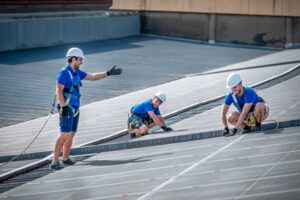 When it comes to maintaining a commercial property, the roof is one of the most critical components. In Trenton, TN, the changing seasons and weather conditions can take a toll on roofing systems, making timely replacements essential. This article explores the importance of commercial roofing replacement, the types of roofing materials available, and the steps involved in the replacement process.
When it comes to maintaining a commercial property, the roof is one of the most critical components. In Trenton, TN, the changing seasons and weather conditions can take a toll on roofing systems, making timely replacements essential. This article explores the importance of commercial roofing replacement, the types of roofing materials available, and the steps involved in the replacement process.
The Importance of Commercial Roofing Replacement
Commercial roofs are designed to withstand various environmental factors, but they do not last forever. Over time, wear and tear can lead to leaks, structural issues, and increased energy costs. Regular inspections and timely replacements can prevent these problems, ensuring the longevity and efficiency of the building.
Preventing Costly Damage
One of the main reasons for replacing a commercial roof is to prevent costly damage. A small leak can quickly escalate into significant structural issues, leading to expensive repairs and potential business interruptions. By replacing an aging roof, property owners can safeguard their investments and maintain a safe environment for employees and customers. Furthermore, proactive roof replacement can enhance the overall aesthetic appeal of the property, which is crucial for businesses that rely on foot traffic and customer impressions. A well-maintained roof reflects professionalism and care, potentially attracting more clients and boosting revenue.
Energy Efficiency
Older roofing systems may not provide the same level of insulation as newer materials. This inefficiency can lead to higher heating and cooling costs, affecting the overall budget of a business. Investing in a new roof can improve energy efficiency, resulting in lower utility bills and a reduced carbon footprint. Additionally, modern roofing technologies, such as reflective coatings and green roofing options, can further enhance energy conservation. These innovations not only help in regulating building temperatures but also contribute to a healthier indoor environment by reducing the reliance on artificial heating and cooling systems. As businesses increasingly focus on sustainability, upgrading to an energy-efficient roofing system can also improve their marketability and align with eco-friendly practices.
Types of Commercial Roofing Materials
When it comes to commercial roofing replacement, there are several materials to choose from, each with its own set of advantages and disadvantages. Understanding these options can help property owners make informed decisions that best suit their needs.
EPDM Roofing
Ethylene Propylene Diene Monomer (EPDM) is a popular choice for flat roofs due to its durability and weather resistance. This rubber roofing material is known for its longevity, often lasting up to 30 years with proper maintenance. EPDM is also relatively easy to install and maintain, making it a cost-effective option for many businesses. Its flexibility allows it to expand and contract with temperature fluctuations, reducing the risk of cracks and leaks. Moreover, EPDM is available in black and white, with the white version providing additional energy efficiency by reflecting sunlight, which can help keep cooling costs down during hot summer months.
TPO Roofing
Thermoplastic Olefin (TPO) is another widely used roofing material, particularly for commercial buildings. TPO is known for its energy efficiency, reflecting sunlight and reducing heat absorption. This characteristic can lead to significant energy savings over time. Additionally, TPO is lightweight and easy to install, making it a popular choice among contractors. The seams of TPO roofs are heat-welded, which creates a strong bond that enhances waterproofing and minimizes the risk of leaks. Furthermore, TPO is often considered an environmentally friendly option, as it can be fully recycled at the end of its life cycle, aligning with the growing trend of sustainability in construction practices.
Modified Bitumen
Modified bitumen roofing is a hybrid of traditional built-up roofing and single-ply systems. It offers excellent waterproofing capabilities and is resistant to UV rays, making it ideal for various climates. This material is typically applied in layers, providing added durability and protection against the elements. The installation process can vary, with options for torch-applied, cold adhesive, or self-adhering methods, allowing for flexibility based on the specific needs of the building. Additionally, modified bitumen can be reinforced with fiberglass or polyester, enhancing its strength and resistance to punctures. This adaptability makes it suitable for both low-slope and steep-slope roofs, catering to a wide range of commercial applications.
The Roofing Replacement Process
Understanding the steps involved in the roofing replacement process can help property owners prepare for the project. A well-executed replacement can minimize disruption to business operations and ensure a successful outcome.
Initial Inspection and Assessment
The first step in the roofing replacement process is a thorough inspection of the existing roof. Roofing professionals will assess the condition of the current system, identifying any issues that need to be addressed. This assessment will help determine whether a complete replacement is necessary or if repairs can extend the roof’s lifespan.
Choosing the Right Material
Once the assessment is complete, property owners will need to choose the right roofing material for their needs. Factors such as budget, energy efficiency, and the specific requirements of the building will influence this decision. Consulting with roofing experts can provide valuable insights and recommendations based on individual circumstances.
Installation and Cleanup
After selecting the material, the installation process begins. Experienced roofing contractors will remove the old roofing system, ensuring proper disposal of materials. The new roof will then be installed according to industry standards, with attention to detail to ensure a watertight seal. Once the installation is complete, a thorough cleanup will follow, leaving the property in pristine condition.
Benefits of Professional Roofing Services
While some property owners may consider a DIY approach to roofing replacement, hiring professional services offers numerous benefits. Experienced contractors bring expertise, ensuring the project is completed safely and efficiently.
Quality Workmanship
Professional roofing companies have the necessary skills and training to deliver high-quality workmanship. They are familiar with the latest techniques and materials, ensuring that the new roof will stand the test of time. This expertise can prevent common mistakes that may occur during a DIY installation.
Warranty and Insurance
Many professional roofing services offer warranties on their work, providing peace of mind for property owners. In addition, reputable contractors carry insurance, protecting against potential liabilities during the project. This coverage is essential for safeguarding both the contractor and the property owner.
Maintaining Your New Roof
Once a commercial roof has been replaced, ongoing maintenance is crucial to ensure its longevity. Regular inspections and maintenance can help identify potential issues before they become significant problems.
Regular Inspections
Scheduling regular inspections with a professional roofing contractor can help catch any issues early on. These inspections should be conducted at least twice a year, as well as after severe weather events. Identifying and addressing problems promptly can extend the life of the roof and prevent costly repairs.
Routine Maintenance
In addition to inspections, routine maintenance tasks such as cleaning gutters, removing debris, and checking for signs of wear can help keep the roof in good condition. Property owners should also be vigilant about monitoring for leaks and other signs of damage, addressing them as soon as they arise.
Conclusion
Commercial roofing replacement is a significant investment that requires careful consideration and planning. In Trenton, TN, understanding the importance of timely replacements, the various roofing materials available, and the steps involved in the process can help property owners make informed decisions. By hiring professional services and committing to regular maintenance, businesses can ensure their roofs remain in excellent condition for years to come.
Ready to protect your commercial property in Trenton, TN with a top-tier roofing replacement? Trust the expertise of Commercial Roofing Rana, a family-owned business with a legacy of quality since 1983. Specializing in Duro-Last roofing systems, we ensure your commercial roofs are impeccably installed for maximum durability and protection. Don’t let minor leaks turn into costly damages—our licensed professionals are committed to excellence, serving the Mid-South with pride. Schedule Now to secure the superior service your business deserves.
